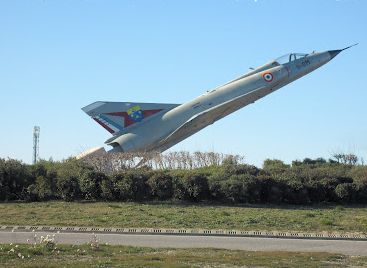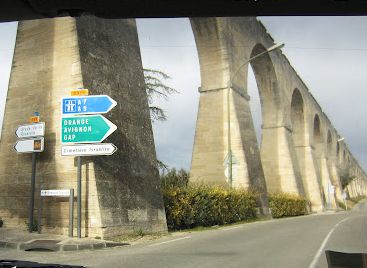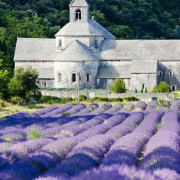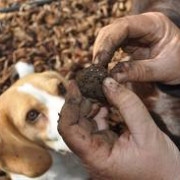
We spent quite a lot of time driving in Provence and the rest of France on vacations when our children were very young, and it was always a lot of fun. France is very kid friendly, and we had no problem taking the children into restaurants where we would often see other families enjoying a meal together

Even in the middle of winter, this Roadside Picnic Stop is pretty and welcoming for travelers. This one is on the road between Sablet and Carpentras.
Along the Autoroutes, there were great roadside rest stops – always plenty of space for the kids to stretch their legs – often with picnic tables and benches, restrooms and play structures
You will even see nice picnic spots along minor roads throughout Provence,
…… and ….. we mustn’t forget the scenic Giratoire
What’s a Giratoire? …… (AKA Rond-Point) – AKA in the UK as a Roundabout
Giratoires are a common feature in Provencal driving – they are also a very helpful one. The regular intersection is replaced with a large roundabout which is far more forgiving for the driver who is not quite sure of which road they should take next. I can’t tell you how many times I have done double takes at Rond-Point
When approaching a Rond-point, you will see a sign that says, “Vous n’avez pas la priorite” – (litereally: “You do not have priority”), it means that when entering the Rond-point, you must give way to the traffic already within it. Once you enter, you can go around as many times as you like
I did intend this post to be a very practical one, with helpful points for anyone planning a driving vacation in Provence, but I hope you will let me indulge in a little fun. I love the Giratoires in Provence, as the circles are often decorated to represent the area or the village that they are closest to, for instance vines growing in the Rond-Points close to well known wine producing villages or lavender on roundabouts of the “routes de la Lavande,” are like the artwork along the Autoroutes, and are very enjoyable. So …. before we get to the practical …. here we go … some pictures of the more unusual Giratoire decorations that I couldn’t resist. They’re fun and especially good if you’re traveling with kids, or kids at heart.

Look who was “hanging out” in the middle of a Giratoire right by Auchan Department Store at Le Pont

Why is this enormous fish chasing a bug, in the middle of a Rond Point not too far from Avignon?? This guy tells us we’re in a region crisscrossed by the Sorgue, Ouveze and Durance Rivers. It does get your attention – doesn’t it? Not too far away from the A7 – in Vedene, heading towards Entreaigues and Bedarrides

A dramatic display which reminds us that the French Air Force Base “Orange-Caritat” is nearby. Shortly after exiting the Autoroute A7 at Orange Sud (Exit 22)

On the road to Beaumes de Venise, the Rond Point draws our attention to just how much wine growing is involved in the daily lives of the people who live in this area.
If you’ve taken pictures of any interesting or fun Roundabouts, I’d love to hear from you or better still we’d all love to see the pics
Now ….. the Practical Information
France has a very good and extensive network of highways and local roads. The French Highway system classifies roads into three categories:
1. The Autoroute system – usually toll roads and identified by the letter A before the route number. For instance, the Autoroute which connects Avignon to Lyon is the A7. All Autoroute signs are in white letters on a blue background.
2. The National Highway system or Route Nationale. These are non-toll, main roads which are identified by the letter N followed by the number. You will see signs for these roads on a green background with white lettering.
3. The local roads or Route Departmentale or “D” roads have black lettering on a yellow background, with the destination names below on black and white arrow signs.
NOTE: You may occasionally see a green E Sign which carries an E followed by a number – these are European Routes which cross borders.

Well sign posted roads make sightseeing in Provence very easy. The signage at this intersection displays Autoroute, Route Nationale and Route Departmentale Sign
Following Directions: French roads are very well signposted – but – a watchpoint: make sure you have an approximate idea of the towns and villages along your route, as ALL roads that will take you to a certain point are signposted, and following certain signs may take you on a somewhat circuitous drive to your destination
When you enter a town or village, if you don’t immediately see signs to your next point, follow the signs that say, “TOUTES DIRECTIONS” (All Directions), you will eventually see a sign pointing in the direction that you wish to proceed.
Radar – Attention! Don’t be lulled by quiet roads as a place to speed, as the French Police have a strong affinity for Radar. Please look for, and observe the speed limits which are prominently posted on Departmental Roads – the speed limit on the Autoroute is 130 kilometers per hour. There are much better and more enjoyable ways to spend your money than paying the heavy fines you will incur for speeding
Using Cell Phones Whilst Driving: Let me quote a Gendarme who pulled me over in the Town of Orange a couple of years ago – “Absolument Interdit!” (Absolutely Forbidden!
Seat Belts, Car Seats and Driving with Children: The use of seat belts when driving is Mandatory. It is against the law for children under the age of 10 to ride in the front seat of a car. Unless there is no back seat, they must ride in the back in an appropriate car sea
Breakdown: All cars must be equipped with a Red Triangle and Yellow Fluorescent Jacket. In case of breakdown, you are required to set up the red triangle an appropriate distance behind the vehicle to warn other drivers of the obstacle, and you must wear the yellow jacket before leaving the vehicle and stepping onto the roadway
NOTE: Please do not leave your car unattended with luggage or any valuables in plain sight. It is best when arriving or departing, to unload your luggage at your destination and then do your sightseeing. If that is not possible, please make sure that luggage is stored in a locked trunk – out of sight
Below are some traffic terms which you may find helpful:
Pietons – Pedestrian
Circulation – Traffic
Feu – Traffic Light
Phare – Headlights
Carrefour – an intersection.
Giratoire or Rond Point – Roundabout
Peage – Toll point along a Toll Road
Vitesse – Speed
Highway signs:
Vent Violent – soyez prudent! – High winds – be careful!
Circulation Buchon – Traffic jam
Vous N’Avez pas la Priorite – you will see this sign as you approach a roundabout. It means that the vehicles within the roundabout have priority of passage and you must give way to them when entering.
Ne pas depasser – No passing or overtaking.
Ralentissez or Ralentir – Slow down
Rappel – Literally: “Remember” this sign is a reminder of a previous speed restriction.
Verglas – Careful – Roadway can have Ice.
Neige – Snow
Gazole – Diesel; “Essence” or “Carburante” – Gas or Petrol; “Sans Plomb” – Unleaded
Chauseee Deforme – Road in poor condition
Sortie- Exit – Note: Autoroute exits are numbered as well as named, so make sure you check the map for your exit number and name. For instance, the exit number to reach Sablet when traveling from Avignon is Sortie 22 – Orange Sud
Bis– Supplementary or additional route
HELPFUL WEBSITE for driving in France – like Google Maps but shows location of Gas Stations and other services en route. It also gives you an indication of the cost of fuel for the trip, and toll charges if you are traveling via Toll roads: www.Mappy.fr If you don’t speak French, there’s a small drop down menu at the top left hand corner of the screen. It shows a French flag and says, “France”. Click on that button and select, “United Kingdom” and it will take you to an English screen – you can then go to the Itinerary and fill in your route.

and ……. last but most important ….. Bonne Route! ….. Have a great trip!

















